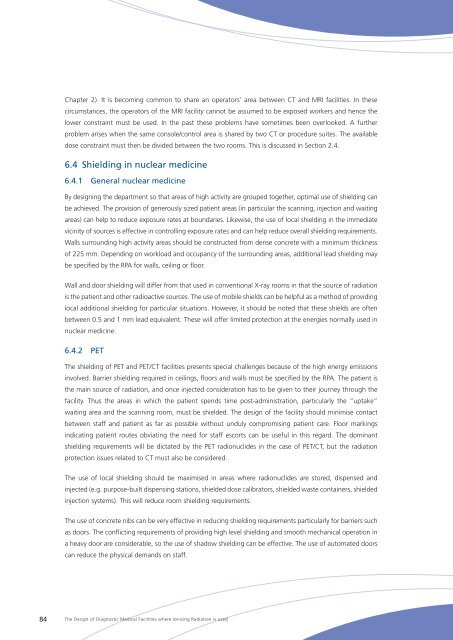The Design of Diagnostic Medical Facilities where ... - ResearchGate
The Design of Diagnostic Medical Facilities where ... - ResearchGate
The Design of Diagnostic Medical Facilities where ... - ResearchGate
Create successful ePaper yourself
Turn your PDF publications into a flip-book with our unique Google optimized e-Paper software.
Chapter 2). It is becoming common to share an operators’ area between CT and MRI facilities. In these<br />
circumstances, the operators <strong>of</strong> the MRI facility cannot be assumed to be exposed workers and hence the<br />
lower constraint must be used. In the past these problems have sometimes been overlooked. A further<br />
problem arises when the same console/control area is shared by two CT or procedure suites. <strong>The</strong> available<br />
dose constraint must then be divided between the two rooms. This is discussed in Section 2.4.<br />
6.4 Shielding in nuclear medicine<br />
6.4.1 General nuclear medicine<br />
By designing the department so that areas <strong>of</strong> high activity are grouped together, optimal use <strong>of</strong> shielding can<br />
be achieved. <strong>The</strong> provision <strong>of</strong> generously sized patient areas (in particular the scanning, injection and waiting<br />
areas) can help to reduce exposure rates at boundaries. Likewise, the use <strong>of</strong> local shielding in the immediate<br />
vicinity <strong>of</strong> sources is effective in controlling exposure rates and can help reduce overall shielding requirements.<br />
Walls surrounding high activity areas should be constructed from dense concrete with a minimum thickness<br />
<strong>of</strong> 225 mm. Depending on workload and occupancy <strong>of</strong> the surrounding areas, additional lead shielding may<br />
be specified by the RPA for walls, ceiling or floor.<br />
Wall and door shielding will differ from that used in conventional X‐ray rooms in that the source <strong>of</strong> radiation<br />
is the patient and other radioactive sources. <strong>The</strong> use <strong>of</strong> mobile shields can be helpful as a method <strong>of</strong> providing<br />
local additional shielding for particular situations. However, it should be noted that these shields are <strong>of</strong>ten<br />
between 0.5 and 1 mm lead equivalent. <strong>The</strong>se will <strong>of</strong>fer limited protection at the energies normally used in<br />
nuclear medicine.<br />
6.4.2 PET<br />
<strong>The</strong> shielding <strong>of</strong> PET and PET/CT facilities presents special challenges because <strong>of</strong> the high energy emissions<br />
involved. Barrier shielding required in ceilings, floors and walls must be specified by the RPA. <strong>The</strong> patient is<br />
the main source <strong>of</strong> radiation, and once injected consideration has to be given to their journey through the<br />
facility. Thus the areas in which the patient spends time post-administration, particularly the “uptake”<br />
waiting area and the scanning room, must be shielded. <strong>The</strong> design <strong>of</strong> the facility should minimise contact<br />
between staff and patient as far as possible without unduly compromising patient care. Floor markings<br />
indicating patient routes obviating the need for staff escorts can be useful in this regard. <strong>The</strong> dominant<br />
shielding requirements will be dictated by the PET radionuclides in the case <strong>of</strong> PET/CT, but the radiation<br />
protection issues related to CT must also be considered.<br />
<strong>The</strong> use <strong>of</strong> local shielding should be maximised in areas <strong>where</strong> radionuclides are stored, dispensed and<br />
injected (e.g. purpose-built dispensing stations, shielded dose calibrators, shielded waste containers, shielded<br />
injection systems). This will reduce room shielding requirements.<br />
<strong>The</strong> use <strong>of</strong> concrete nibs can be very effective in reducing shielding requirements particularly for barriers such<br />
as doors. <strong>The</strong> conflicting requirements <strong>of</strong> providing high level shielding and smooth mechanical operation in<br />
a heavy door are considerable, so the use <strong>of</strong> shadow shielding can be effective. <strong>The</strong> use <strong>of</strong> automated doors<br />
can reduce the physical demands on staff.<br />
84<br />
<strong>The</strong> <strong>Design</strong> <strong>of</strong> <strong>Diagnostic</strong> <strong>Medical</strong> <strong>Facilities</strong> <strong>where</strong> Ionising Radiation is used
















